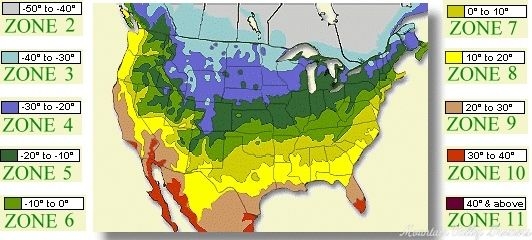Understanding Zones
Zones may be the most misunderstood terms in all of gardening and, yet, can be the reason your garden is successful or not.
There are two parts to zone ratings and they need to work together to insure your plant will have a chance to grow year after year.
The first part is the zone you garden in. These zones range in values from zone 2 which is minus 40 to zone 11 which is 40. The only information your zone gives you is this winter time temperature rating. It does not address summer heat, summer humidity, the soil in your area or any other numerous conditions that may exist where you garden. For instance, we are a zone 8 but have very dry summers while Georgia might also be a zone 8 but have very humid summers. Same zone but different growing challenges. The second part is the zone given to the plant. Again, this number only relates to the winter time minimum temperature a plant can survive once it is established. Most plants take about a month to become established in spring and summer and can take longer as fall approaches. It is important to note that zone ratings for plants are based on plants grown in the ground and not in containers. The ground provides an insulating value not found in containers.

Let’s start with YOUR zone. The map shows all of the United States except for Alaska and Hawaii. Alaska is mostly zone 2 and Hawaii is zone 11. The most accurate way to think of your zone is to know your minimum winter time temperature. Most areas do not reach the minimum low every year. In fact, it may only be once in a blue moon that your zone reaches that low temperature. For instance, we are in zone 8 which can go down to 10 degrees. In thirty five years we have seen this happen three times. Normally our minimum temperatures are in the mid to upper 20’s. When we have reached our minimum temperatures, we did lose a few things that weren’t rated for our zone.
Now for your PLANT’S zone. Now that you know your zone, it is important to know the zone of the plant you want to grow. You might also consider growing plants outside your zone as annuals. For instance, you may not be able to over winter rosemary but you may be able to grow and harvest enough rosemary in one season to use over both the growing season and throughout the winter. Some folks grow pretty perennials as annuals and realize they will have to start again the next spring. Salvias are often grown this way. They provide so much color in the landscape that it makes it worthwhile to grow them for one season.
So whether you are cropping a plant or enjoying its flowers, growing a perennial outside your zone can be a satisfying annual experience.
